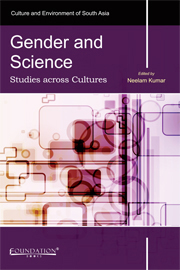Book contents
- Frontmatter
- Contents
- List of Contributors
- Acknowledgements
- Introduction: Reflections and Realities across Cultures
- Section I Approaches and Perspectives
- Section II Illustrative Examples
- 6 Women and Science in the Netherlands: A Dutch Case
- 7 Japanese Women Scientists: Trends and Strategies
- 8 Saudi Women: Their Role in Science and Education
- 9 Changing the Facts: Gender Dimensions of the South African Public Science System
- 10 Demographic Inertia and the Glass Ceiling in American Science (1979–2000)
- 11 Women in Science in France
- 12 Women and Science: Issues and Perspectives in the Indian Context
- Conclusion: The Persistent Patterns!
- Bibliography
- Index
8 - Saudi Women: Their Role in Science and Education
from Section II - Illustrative Examples
Published online by Cambridge University Press: 05 May 2013
- Frontmatter
- Contents
- List of Contributors
- Acknowledgements
- Introduction: Reflections and Realities across Cultures
- Section I Approaches and Perspectives
- Section II Illustrative Examples
- 6 Women and Science in the Netherlands: A Dutch Case
- 7 Japanese Women Scientists: Trends and Strategies
- 8 Saudi Women: Their Role in Science and Education
- 9 Changing the Facts: Gender Dimensions of the South African Public Science System
- 10 Demographic Inertia and the Glass Ceiling in American Science (1979–2000)
- 11 Women in Science in France
- 12 Women and Science: Issues and Perspectives in the Indian Context
- Conclusion: The Persistent Patterns!
- Bibliography
- Index
Summary
Science education in most Muslim and Arab countries begins between the age of six and seven and is taught as an integrated compulsory subject to both boys as well as girls. The major science disciplines are then studied separately in the last two or three years of the high-school education (Sedgwick, 2001). Fewer girls than boys are enrolled in high school science curricula. There are various reasons related to gender stereotyping such as misleading perceptions that science and technology are subjects more suitable for boys. Another reason is the failure of the curricula to relate science and technology to the everyday life of women. Thus, there is a self-inhibition among school girls that affects not only the number of young women entering universities to study science and technology subjects, but it also results in the reluctance of talented women in introducing their own values and visions into a working world dominated by men.
Arab countries vary greatly in their culture, traditions, and social system. There is a wide range of attitudes towards educating women at the university level, for example in Egypt, women have attended university since the 1920s, whereas in other countries a university education for women is a recent phenomenon. Saudi women were admitted to formal university education in 1973. Although women have the right to a university education, those in more traditional, rural areas of ten do not exercise that right, whether for social, economic, or family reasons.
- Type
- Chapter
- Information
- Gender and ScienceStudies across Cultures, pp. 172 - 184Publisher: Foundation BooksPrint publication year: 2012



